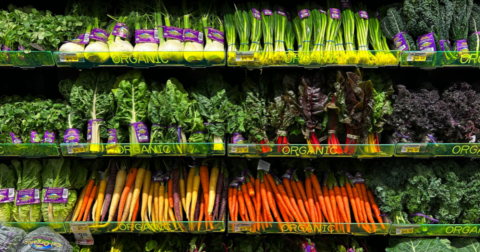News
Slaughterhouses Harbor Antibiotic-Resistant Bacteria That Give People Urinary Tract Infections
Food•6 min read
Explainer
Organic meat isn’t necessarily better for the environment, but the certification does afford farm animals a bit more living space.


Words by Dawn Attride
At the supermarket, you’re often met with a choice: organic or not? Organic foods — largely free of synthetic pesticides, hormones and antibiotics — are synonymous with sustainability in the minds of many shoppers. But sustainability is a fraught and complex measure — does it mean better for you or for the planet? And how do farm animals, farmers and workers fare? About the only measure that’s simple here is the nutrition, which remains the same whether you buy organic or conventional foods. After that, however, the tradeoffs quickly become complicated.
When it comes to the environment, organic food isn’t necessarily better and can even be worse, in part because it requires more land to raise animals and grow their feed. In other words, that additional land means farm animals get a little more living space under U.S. organic rules. But unfortunately, unless we cut back on how much meat we eat, farming with even more land comes at a steep climate cost (and we’re already way over budget).
After reviewing publicly available data and the scientific literature on the impacts of organic versus conventionally farmed meat, Sentient breaks down the tradeoffs.
A 2017 review of hundreds of studies compared the environmental impacts of organic foods with their conventionally produced counterparts. The researchers looked at life cycle assessments to account for all the inputs, outputs and environmental effects of a food system. According to the findings, organic meat requires slightly lower energy on average than conventional meat — things like machinery and fertilizer production — but is less environmentally friendly in terms of nutrient runoff and higher land use.
Organic livestock standards require that farm animals be allotted more land than intensive agriculture operations, such as factory farming. Across all animal products (including milk and eggs), organic requires around 75 percent more land based on our analysis of the 2017 paper.
What we do with land has serious opportunities or consequences for climate change. For example, peatlands can suck in huge amounts of carbon by sequestration, and trees can also capture and store carbon. But if we were to expand how much of our food was sourced from organic farms, we would have to clear more land. When we clear land for farming, it loses its capacity to store carbon for as long as it stays a farm (essentially until it is rewilded), which is very bad for the planet.
As it stands, over a third of land globally is used for agriculture, resulting in deforestation in places like the Amazon rainforest. If we keep eating meat at the rate we do now, and the population keeps on growing, which is what the United Nations expects to happen, we will drive up greenhouse gas emissions even further, making the planet a more challenging place to live.
When we dig into the details, “better” depends on what you measure and how. A different review focusing on Western European farming found that organic animal foods have lower carbon emissions per hectare than producing those foods conventionally. But here’s where things get tricky: this was mainly due to land management practices used in organic farming, which the authors argued would increase the carbon sequestration of the system.
The argument for this kind of farming — sometimes called regenerative or climate-smart — doesn’t track with the many studies showing these carbon farming practices tend to only add carbon to soils for a short period of time and then release it back into the atmosphere, which is not what you need for climate mitigation. In any event, when the researchers measured emissions by weight of meat produced, organic animal foods emitted more greenhouse gases per pound.
While organic foods’ inefficiency can contribute to higher emissions, it can be better in terms of welfare for farm animals. More land means more room for animals to graze than what they experience in factory farms. Raising more animals in the most confined spaces translates to lower emissions, while the higher-emissions organic livestock farms can offer animals better living conditions. This is the crux of the tradeoff between organic and conventional meat.
In the United States, demand for organic food is surging, despite only a tiny fraction of farmland being used for organic food production. Between 2023 and 2024, organic meat sales increased 14.3 percent in dollar terms to hit $3.1 billion. Although typically more expensive, the label is in high demand, particularly among younger generations. A recent survey by the Organic Trade Association found that two-thirds of young consumers look for the label in nearly every food purchase.
Keeping up with this demand means using more land. What would happen if animal farming went entirely organic — and humans ate the same amount of meat, eggs and dairy, but using roughly 75 percent more land? The land area needed for farm animals would increase from 36 percent to 63 percent of the world’s habitable area. Under current global warming estimates, this expansion likely wouldn’t be sustainable given the dire need for carbon-cutting solutions which involves avoiding deforestation and preserving land.
Based on the way we eat now, organic livestock farming is not scalable to feed the projected 9.7 billion people who will be living on the planet by 2050. While organic production gives animals more space, that higher land usage isn’t so good for climate change. But there are alternatives. Proteins like beans — whether organic or conventional — could substitute the growing protein demand while remaining low on emissions and avoiding typical animal welfare concerns.